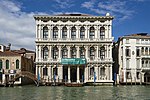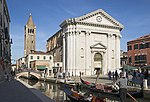Palazzo Loredan dell'Ambasciatore
Gothic architecture in VeniceHouses completed in the 15th centuryLoredan familyPalaces in Sestiere DorsoduroPalaces on the Grand Canal (Venice) ... and 2 more
Residences of the House of LoredanVenetian Gothic architecture

Palazzo Loredan dell'Ambasciatore is a late 15th-century Gothic palace in Venice, Italy, that once belonged to the noble Loredan family. Located in the Dorsoduro sestiere (quarter), it was called "dell'Ambasciatore" because it was offered as a home of the ambassadors of the Austrian Empire to the Republic by Doge Francesco Loredan.
Excerpt from the Wikipedia article Palazzo Loredan dell'Ambasciatore (License: CC BY-SA 3.0, Authors, Images).Palazzo Loredan dell'Ambasciatore
Calle dei Cerchieri, Mestre Venezia-Murano-Burano
Geographical coordinates (GPS) Address Nearby Places Show on map
Geographical coordinates (GPS)
| Latitude | Longitude |
|---|---|
| N 45.432777777778 ° | E 12.327222222222 ° |
Address
Palazzo Moro
Calle dei Cerchieri
30170 Mestre, Venezia-Murano-Burano
Veneto, Italy
Open on Google Maps










